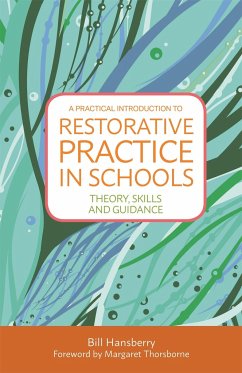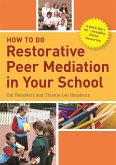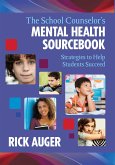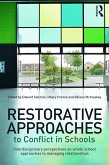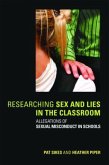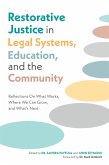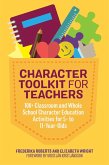Bill Hansberry
A Practical Introduction to Restorative Practice in Schools
Theory, Skills and Guidance
Schade – dieser Artikel ist leider ausverkauft. Sobald wir wissen, ob und wann der Artikel wieder verfügbar ist, informieren wir Sie an dieser Stelle.
Bill Hansberry
A Practical Introduction to Restorative Practice in Schools
Theory, Skills and Guidance
- Broschiertes Buch
- Merkliste
- Auf die Merkliste
- Bewerten Bewerten
- Teilen
- Produkt teilen
- Produkterinnerung
- Produkterinnerung
A proven approach to conflict resolution in schools, this book shows how restorative justice can be successfully implemented in your school. Suitable for use in educational settings for children of all ages, it describes what restorative justice is and how it can be used to achieve school-wide benefits.
Andere Kunden interessierten sich auch für
![How to Do Restorative Peer Mediation in Your School How to Do Restorative Peer Mediation in Your School]() Bill HansberryHow to Do Restorative Peer Mediation in Your School44,99 €
Bill HansberryHow to Do Restorative Peer Mediation in Your School44,99 €![The School Counselor's Mental Health Sourcebook The School Counselor's Mental Health Sourcebook]() Rick AugerThe School Counselor's Mental Health Sourcebook16,99 €
Rick AugerThe School Counselor's Mental Health Sourcebook16,99 €![Restorative Approaches to Conflict in Schools Restorative Approaches to Conflict in Schools]() Restorative Approaches to Conflict in Schools71,99 €
Restorative Approaches to Conflict in Schools71,99 €![Researching Sex and Lies in the Classroom Researching Sex and Lies in the Classroom]() Pat SikesResearching Sex and Lies in the Classroom54,99 €
Pat SikesResearching Sex and Lies in the Classroom54,99 €![Skinned Knees and ABCs Skinned Knees and ABCs]() Debarshi RoySkinned Knees and ABCs61,99 €
Debarshi RoySkinned Knees and ABCs61,99 €![Restorative Justice in Legal Systems, Education and the Community Restorative Justice in Legal Systems, Education and the Community]() Sandra PavelkaRestorative Justice in Legal Systems, Education and the Community47,99 €
Sandra PavelkaRestorative Justice in Legal Systems, Education and the Community47,99 €![Character Toolkit for Teachers Character Toolkit for Teachers]() Frederika RobertsCharacter Toolkit for Teachers31,99 €
Frederika RobertsCharacter Toolkit for Teachers31,99 €
A proven approach to conflict resolution in schools, this book shows how restorative justice can be successfully implemented in your school. Suitable for use in educational settings for children of all ages, it describes what restorative justice is and how it can be used to achieve school-wide benefits.
Produktdetails
- Produktdetails
- Verlag: Jessica Kingsley Publishers
- Seitenzahl: 312
- Erscheinungstermin: 21. Juli 2016
- Englisch
- Abmessung: 282mm x 173mm x 10mm
- Gewicht: 522g
- ISBN-13: 9781849057073
- ISBN-10: 1849057079
- Artikelnr.: 43489571
- Herstellerkennzeichnung
- Libri GmbH
- Europaallee 1
- 36244 Bad Hersfeld
- gpsr@libri.de
- Verlag: Jessica Kingsley Publishers
- Seitenzahl: 312
- Erscheinungstermin: 21. Juli 2016
- Englisch
- Abmessung: 282mm x 173mm x 10mm
- Gewicht: 522g
- ISBN-13: 9781849057073
- ISBN-10: 1849057079
- Artikelnr.: 43489571
- Herstellerkennzeichnung
- Libri GmbH
- Europaallee 1
- 36244 Bad Hersfeld
- gpsr@libri.de
Bill Hansberry runs an education consultancy (www.hansberryec.com.au). Bill is widely recognised for his knowledge about behaviour management, restorative justice and cultural renewal in educational settings. He is also known for his passion for relational teaching, strategic community building and Circle Time, as well as his unique and engaging style in facilitating professional learning workshops for schools, school clusters and other organisations. Bill lives in Adelaide, Australia.
Acknowledgements. Preface. Foreword. Section 1. Thinking Restoratively:
Challenging Paradigms About What to Do When Things Go Wrong. 1. Case Study
- Tristan and Jason. 2. Courage, Connectedness and Restorative work. 3.
Re-Thinking the Role of Grownups When Things Go Wrong. 4. Dealing
Restoratively With Tristan and Jason. 5. Different Questions, Different
Outcomes. Section 2. Feeling Restoratively: A Psychological Framework for
Restorative Practices. 6. Silvan Tomkins and Humans as Emotional Beings. 7.
Affect - What Makes Humans Tick. 8. A Blueprint for Mentally Healthy
Schools. 9. Shame and Humiliation. 10. Grasping the Nettle: Shame's
Difficult Demand. 11. The Compass of Shame. Section 3. Working
Restoratively: Restorative Approaches for Different Ages and Situations.
12. Continuums of Responses to Disruption and Wrongdoing. 13. Positive
Behaviour Correction. 14. Affective Statements and Conversations. 15. The
individual Conference. 16. The Small Group Conference. 17. The Large Group
Conference. 18. The Classroom Conference. 19. The Community Conference. 20.
The Leaving Well Conference. 21. Better Restorative Conversations. 22.
Circles for Building Community and Teaching Restorative Thinking. Section
4. Ending Restoratively: Follow Up, Accountability and Managing a
Conferencing Program. 23. What Have We Agreed to Here? 24. Creating
Conference Agreements. 25. Recording and Managing New Conference
Agreements. 26. After the Conference: Relationship Management and
Accountability. 27. How to Review Conference Agreements. 28. Keeping
Colleagues in the Loop. 29. Keeping Parents in the Loop. Conclusion.
Appendix. References.
Challenging Paradigms About What to Do When Things Go Wrong. 1. Case Study
- Tristan and Jason. 2. Courage, Connectedness and Restorative work. 3.
Re-Thinking the Role of Grownups When Things Go Wrong. 4. Dealing
Restoratively With Tristan and Jason. 5. Different Questions, Different
Outcomes. Section 2. Feeling Restoratively: A Psychological Framework for
Restorative Practices. 6. Silvan Tomkins and Humans as Emotional Beings. 7.
Affect - What Makes Humans Tick. 8. A Blueprint for Mentally Healthy
Schools. 9. Shame and Humiliation. 10. Grasping the Nettle: Shame's
Difficult Demand. 11. The Compass of Shame. Section 3. Working
Restoratively: Restorative Approaches for Different Ages and Situations.
12. Continuums of Responses to Disruption and Wrongdoing. 13. Positive
Behaviour Correction. 14. Affective Statements and Conversations. 15. The
individual Conference. 16. The Small Group Conference. 17. The Large Group
Conference. 18. The Classroom Conference. 19. The Community Conference. 20.
The Leaving Well Conference. 21. Better Restorative Conversations. 22.
Circles for Building Community and Teaching Restorative Thinking. Section
4. Ending Restoratively: Follow Up, Accountability and Managing a
Conferencing Program. 23. What Have We Agreed to Here? 24. Creating
Conference Agreements. 25. Recording and Managing New Conference
Agreements. 26. After the Conference: Relationship Management and
Accountability. 27. How to Review Conference Agreements. 28. Keeping
Colleagues in the Loop. 29. Keeping Parents in the Loop. Conclusion.
Appendix. References.
Acknowledgements. Preface. Foreword. Section 1. Thinking Restoratively:
Challenging Paradigms About What to Do When Things Go Wrong. 1. Case Study
- Tristan and Jason. 2. Courage, Connectedness and Restorative work. 3.
Re-Thinking the Role of Grownups When Things Go Wrong. 4. Dealing
Restoratively With Tristan and Jason. 5. Different Questions, Different
Outcomes. Section 2. Feeling Restoratively: A Psychological Framework for
Restorative Practices. 6. Silvan Tomkins and Humans as Emotional Beings. 7.
Affect - What Makes Humans Tick. 8. A Blueprint for Mentally Healthy
Schools. 9. Shame and Humiliation. 10. Grasping the Nettle: Shame's
Difficult Demand. 11. The Compass of Shame. Section 3. Working
Restoratively: Restorative Approaches for Different Ages and Situations.
12. Continuums of Responses to Disruption and Wrongdoing. 13. Positive
Behaviour Correction. 14. Affective Statements and Conversations. 15. The
individual Conference. 16. The Small Group Conference. 17. The Large Group
Conference. 18. The Classroom Conference. 19. The Community Conference. 20.
The Leaving Well Conference. 21. Better Restorative Conversations. 22.
Circles for Building Community and Teaching Restorative Thinking. Section
4. Ending Restoratively: Follow Up, Accountability and Managing a
Conferencing Program. 23. What Have We Agreed to Here? 24. Creating
Conference Agreements. 25. Recording and Managing New Conference
Agreements. 26. After the Conference: Relationship Management and
Accountability. 27. How to Review Conference Agreements. 28. Keeping
Colleagues in the Loop. 29. Keeping Parents in the Loop. Conclusion.
Appendix. References.
Challenging Paradigms About What to Do When Things Go Wrong. 1. Case Study
- Tristan and Jason. 2. Courage, Connectedness and Restorative work. 3.
Re-Thinking the Role of Grownups When Things Go Wrong. 4. Dealing
Restoratively With Tristan and Jason. 5. Different Questions, Different
Outcomes. Section 2. Feeling Restoratively: A Psychological Framework for
Restorative Practices. 6. Silvan Tomkins and Humans as Emotional Beings. 7.
Affect - What Makes Humans Tick. 8. A Blueprint for Mentally Healthy
Schools. 9. Shame and Humiliation. 10. Grasping the Nettle: Shame's
Difficult Demand. 11. The Compass of Shame. Section 3. Working
Restoratively: Restorative Approaches for Different Ages and Situations.
12. Continuums of Responses to Disruption and Wrongdoing. 13. Positive
Behaviour Correction. 14. Affective Statements and Conversations. 15. The
individual Conference. 16. The Small Group Conference. 17. The Large Group
Conference. 18. The Classroom Conference. 19. The Community Conference. 20.
The Leaving Well Conference. 21. Better Restorative Conversations. 22.
Circles for Building Community and Teaching Restorative Thinking. Section
4. Ending Restoratively: Follow Up, Accountability and Managing a
Conferencing Program. 23. What Have We Agreed to Here? 24. Creating
Conference Agreements. 25. Recording and Managing New Conference
Agreements. 26. After the Conference: Relationship Management and
Accountability. 27. How to Review Conference Agreements. 28. Keeping
Colleagues in the Loop. 29. Keeping Parents in the Loop. Conclusion.
Appendix. References.

